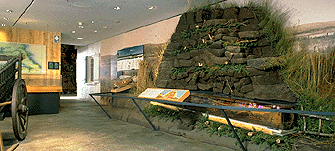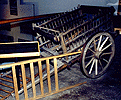Canada Hall
 Early Acadia
Early Acadia
Although fishermen and whalers occasionally wintered over, and fur traders established trading posts in the St. Lawrence Valley, there were no permanent European settlements in North America until the early 1600s.
In the Atlantic region, French settlements were centred mainly in the salt-marsh lowlands around the Bay of Fundy, known as Acadia. Settlers originally came to work at the fur-trade post at Port Royal, established in 1605, but they later turned to farming. For a brief period, Acadia was lost to the English, but by the 1630s, it was established as a French colony to counterbalance the British presence in New England. Many of the French colonists came from western France, a region that is environmentally similar to Acadia, so it is not surprising that their traditional agricultural methods were useful in farming the new land. For example, dike making, a technique that had been used successfully to reclaim salt marshes in Holland and France, was equally effective in Acadia.

The Acadian exhibit shows a cross section of a dike built to convert the salt marshes into rich farmland in the Bay of Fundy. The principle behind dike-making technology was quite simple: sections of marshland were walled off by the dikes in order to prevent tidal flooding. The dikes were usually built from sod, reinforced with logs or branches. Irrigation canals allowed rainwater to flow through sluices called aboiteaux, located at the base of the dikes, in order to drain the marsh. The sluices were made from hollowed logs or planks. A valve located at the ocean end of the sluice closed when the tide was high, preventing the sea water from entering the reclaimed marshland. Rain gradually leached the salt from the land, creating a fertile plain where farmers could cultivate crops such as wheat and flax.
 Roads in farming areas often led along the tops of dikes. Carts were
used for local travel. No vehicle has survived from early Acadia, but
historians believe Acadian carts resembled those found in France.
Constructed with either four wheels or two (like the replica at right),
they would have been drawn by oxen or horses.
Roads in farming areas often led along the tops of dikes. Carts were
used for local travel. No vehicle has survived from early Acadia, but
historians believe Acadian carts resembled those found in France.
Constructed with either four wheels or two (like the replica at right),
they would have been drawn by oxen or horses.
Farming settlements were almost totally self-sufficient. Profitable trade with the French and the English allowed the Acadians to remain politically neutral and to flourish with little outside help for over 100 years.

